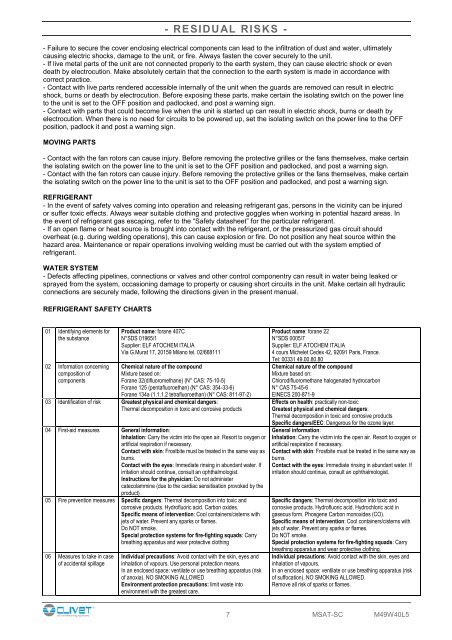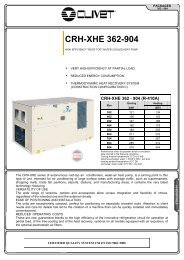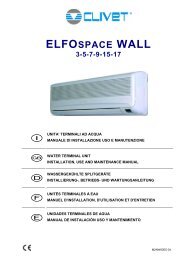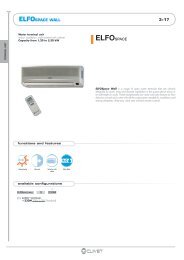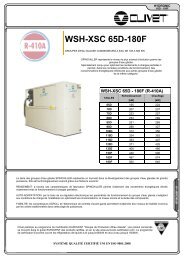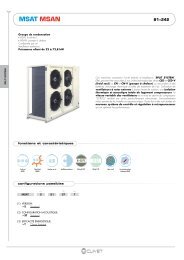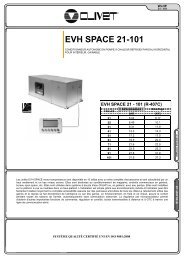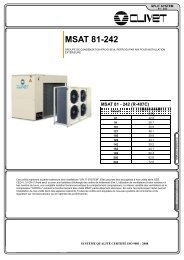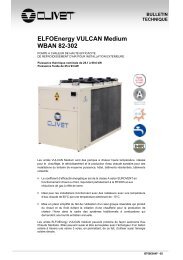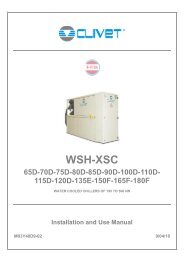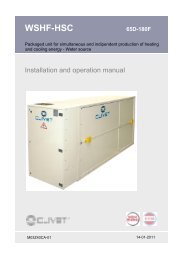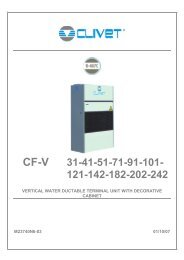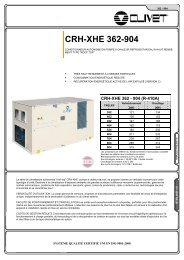MSAT-SC - Delta-Temp
MSAT-SC - Delta-Temp
MSAT-SC - Delta-Temp
Create successful ePaper yourself
Turn your PDF publications into a flip-book with our unique Google optimized e-Paper software.
- RESIDUAL RISKS -- Failure to secure the cover enclosing electrical components can lead to the infiltration of dust and water, ultimatelycausing electric shocks, damage to the unit, or fire. Always fasten the cover securely to the unit.- If live metal parts of the unit are not connected properly to the earth system, they can cause electric shock or evendeath by electrocution. Make absolutely certain that the connection to the earth system is made in accordance withcorrect practice.- Contact with live parts rendered accessible internally of the unit when the guards are removed can result in electricshock, burns or death by electrocution. Before exposing these parts, make certain the isolating switch on the power lineto the unit is set to the OFF position and padlocked, and post a warning sign.- Contact with parts that could become live when the unit is started up can result in electric shock, burns or death byelectrocution. When there is no need for circuits to be powered up, set the isolating switch on the power line to the OFFposition, padlock it and post a warning sign.MOVING PARTS- Contact with the fan rotors can cause injury. Before removing the protective grilles or the fans themselves, make certainthe isolating switch on the power line to the unit is set to the OFF position and padlocked, and post a warning sign.- Contact with the fan rotors can cause injury. Before removing the protective grilles or the fans themselves, make certainthe isolating switch on the power line to the unit is set to the OFF position and padlocked, and post a warning sign.REFRIGERANT- In the event of safety valves coming into operation and releasing refrigerant gas, persons in the vicinity can be injuredor suffer toxic effects. Always wear suitable clothing and protective goggles when working in potential hazard areas. Inthe event of refrigerant gas escaping, refer to the “Safety datasheet” for the particular refrigerant.- If an open flame or heat source is brought into contact with the refrigerant, or the pressurized gas circuit shouldoverheat (e.g. during welding operations), this can cause explosion or fire. Do not position any heat source within thehazard area. Maintenance or repair operations involving welding must be carried out with the system emptied ofrefrigerant.WATER SYSTEM- Defects affecting pipelines, connections or valves and other control componentry can result in water being leaked orsprayed from the system, occasioning damage to property or causing short circuits in the unit. Make certain all hydraulicconnections are securely made, following the directions given in the present manual.REFRIGERANT SAFETY CHARTS01 Identifying elements forthe substance02 Information concerningcomposition ofcomponentsProduct name: forane 407CN°SDS 01965/1Supplier: ELF ATOCHEM ITALIAVia G.Murat 17, 20159 Milano tel. 02/668111Chemical nature of the compoundMixture based on:Forane 32(difluoromethane) (N° CAS: 75-10-5)Forane 125 (pentafluoroethan) (N° CAS: 354-33-6)Forane 134a (1.1.1.2 tetrafluoroethan) (N° CAS: 811-97-2)03 Identification of risk Greatest physical and chemical dangers:Thermal decomposition in toxic and corrosive products04 First-aid measures General information:Inhalation: Carry the victim into the open air. Resort to oxygen orartificial respiration if necessary.Contact with skin: Frostbite must be treated in the same way asburns.Contact with the eyes: Immediate rinsing in abundant water. Ifirritation should continue, consult an ophthalmologist.Instructions for the physician: Do not administercatecolammine (due to the cardiac sensitisation provoked by theproduct)05 Fire prevention measures Specific dangers: Thermal decomposition into toxic andcorrosive products. Hydrofluoric acid. Carbon oxides.Specific means of intervention: Cool containers/cisterns withjets of water. Prevent any sparks or flames.Do NOT smoke.Special protection systems for fire-fighting squads: Carrybreathing apparatus and wear protective clothing06 Measures to take in caseof accidental spillageIndividual precautions: Avoid contact with the skin, eyes andinhalation of vapours. Use personal protection means.In an enclosed space: ventilate or use breathing apparatus (riskof anoxia). NO SMOKING ALLOWEDEnvironment protection precautions: limit waste intoenvironment with the greatest care.Product name: forane 22N°SDS 0005/7Supplier: ELF ATOCHEM ITALIA4 cours Michelet Cedex 42, 92091 Paris, France.Tel: 00331 49.00.80.80Chemical nature of the compoundMixture based on:Chlorodifluoromethane halogenated hydrocarbonN° CAS 75-45-6EINECS 200-871-9Effects on health: practically non-toxicGreatest physical and chemical dangers:Thermal decomposition in toxic and corrosive productsSpecific dangers/EEC: Dangerous for the ozone layer.General information:Inhalation: Carry the victim into the open air. Resort to oxygen orartificial respiration if necessary.Contact with skin: Frostbite must be treated in the same way asburns.Contact with the eyes: Immediate rinsing in abundant water. Ifirritation should continue, consult an ophthalmologist.Specific dangers: Thermal decomposition into toxic andcorrosive products. Hydrofluoric acid. Hydrochloric acid ingaseous form. Phosgene Carbon monoxides (CO).Specific means of intervention: Cool containers/cisterns withjets of water. Prevent any sparks or flames.Do NOT smoke.Special protection systems for fire-fighting squads: Carrybreathing apparatus and wear protective clothing.Individual precautions: Avoid contact with the skin, eyes andinhalation of vapours.In an enclosed space: ventilate or use breathing apparatus (riskof suffocation). NO SMOKING ALLOWED.Remove all risk of sparks or flames.7 <strong>MSAT</strong>-<strong>SC</strong> M49W40L5


